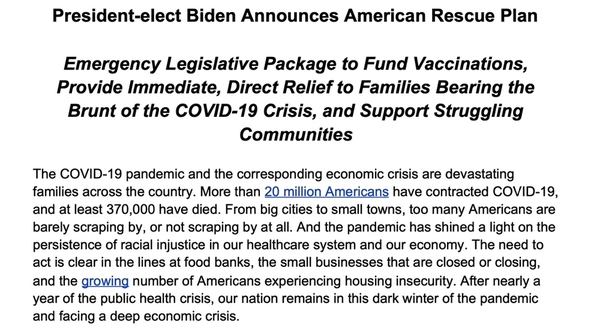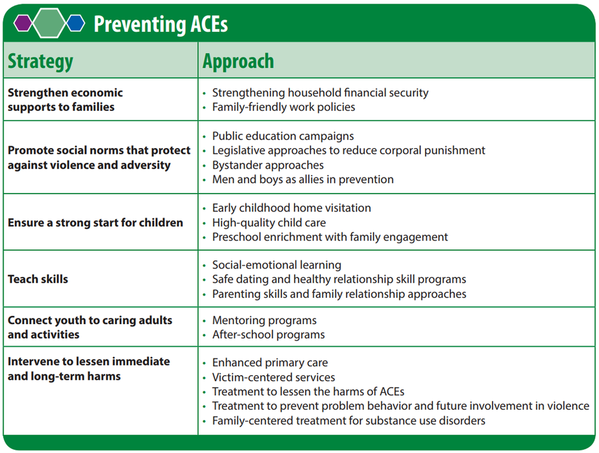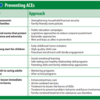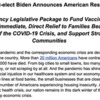If you are finding it hard to keep track of all the Executive Orders, presidential directives, and release of plans by the Biden-Harris Administration and you’re interested in the key elements that hold promise for strengthening families and improving the lives of children, you might find the succinct 19-page document on the American Rescue Plan (the $1.9 trillion relief plan) valuable in an ever more complicated policy and political landscape. The recommendations in this document (also attached) were outlined first in a speech in Wilmington, Delaware by then President-elect Biden on Jan. 14 and were the topic of a meeting of bipartisan bicameral congressional leaders and the White House on Jan. 24. The COVID-specific recommendations are detailed in National Strategy for COVID-19 Response and Pandemic Preparedness, covering vaccines, testing, and reopening schools. President Biden remarked on the American Rescue Plan at a briefing on Jan. 22 saying support for the plan to reverse the economic damage of the pandemic includes leading economists as well as bipartisan elected officials at all levels of government.
The COVID-specific recommendations are detailed in National Strategy for COVID-19 Response and Pandemic Preparedness, covering vaccines, testing, and reopening schools. President Biden remarked on the American Rescue Plan at a briefing on Jan. 22 saying support for the plan to reverse the economic damage of the pandemic includes leading economists as well as bipartisan elected officials at all levels of government.
Already there is speculation that Biden-Harris $1.9 trillion relief plan is “dead on arrival” on Capitol Hill but the legislative process that is required to implement some of the key elements such as the child tax credit is already underway in committees of jurisdiction (see the Washington Post story of Jan. 22, Senior Democrats drafting plan to give parents at least $3,000 per child in Biden stimulus.) The story reports that the Administration and some Democratic members of Congress would like the proposed child tax credit to be permanent rather than limited to the period of the pandemic.
Several key recommendations align with policy options long supported by child and family advocates prior to the pandemic, creating pressure to make some proposals permanent. The Plan states it “will address the stark, intergenerational inequities that have worsened in the wake of COVID-19. Researchers at Columbia University estimate that these proposals will cut child poverty in half.”

Here are selected proposals from the American Rescue Plan that would strengthen economic supports to families and ensure a strong start for children (see CDC’s “Preventing ACEs: Leveraging the Best Available Evidence):
—Calls on Congress to increase the minimum wage to $15 an hour
—Creates a $25 billion emergency stabilization fund for child care providers
—Adds $15 billion to the already approved December funding of $10 billion for the Child Care and Development Block Grant program to help cover the cost of child care and help rebuild the supply of child care providers
—Increase child care tax credits. The plan says “Families will get back as a tax credit as much as half of their spending on child care for children under age 13, so that they can receive a total of up to $4,000 for one child or $8,000 for two or more children. The tax credit will be refundable, meaning that families who don’t owe a lot in taxes will still benefit.”
—Make changes to the Child Tax Credit so that families with low household income will received added resources. The proposal would “increase the credit to $3,000 per child ($3,600 for a child under 6) and make 17 year-olds qualifying children for the year.” The Child Tax Credit would be fully refundable, meaning that a family could benefit even if they do not have a tax liability.
—Calls for the expansion of the Earned Income Tax Credit to benefit lowest income workers
—Adds $1 billion for states to cover the additional cash assistance that Temporary Assistance to Needy Families (TANF)
—Expands health coverage by increasing the value of the Premium Tax Credit and subsidize continuation health coverage (COBRA)
—Recommends that Congress appropriate $4 billion to the Substance Abuse and Mental Health Services Administration (SAMHSA) and the Health Resources and Services Administration to expand access to behavioral health services
—Requests $20 billion for veterans’ health care needs
—Calls for $800 million to combat increased risk of gender-based violence
Many of these recommendations are time-limited and would not extend beyond the duration of the pandemic even if they make it into a final stimulus package. Awareness and discomfort in America’s lack of investment in its children are growing and could bode well for proposals such as the child tax credit and improvements in the health and nutrition programs that are included in the $1.9 trillion stimulus plan.


Comments (0)